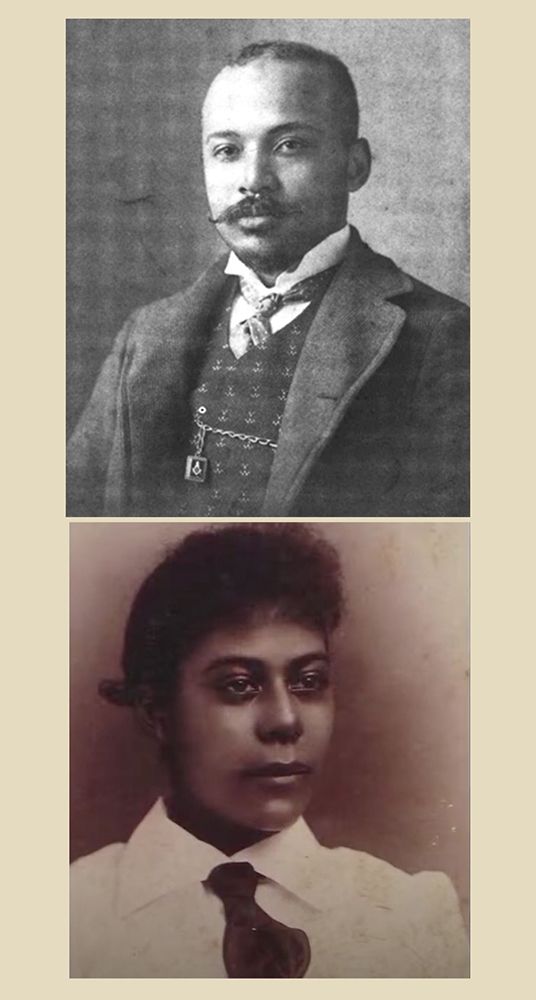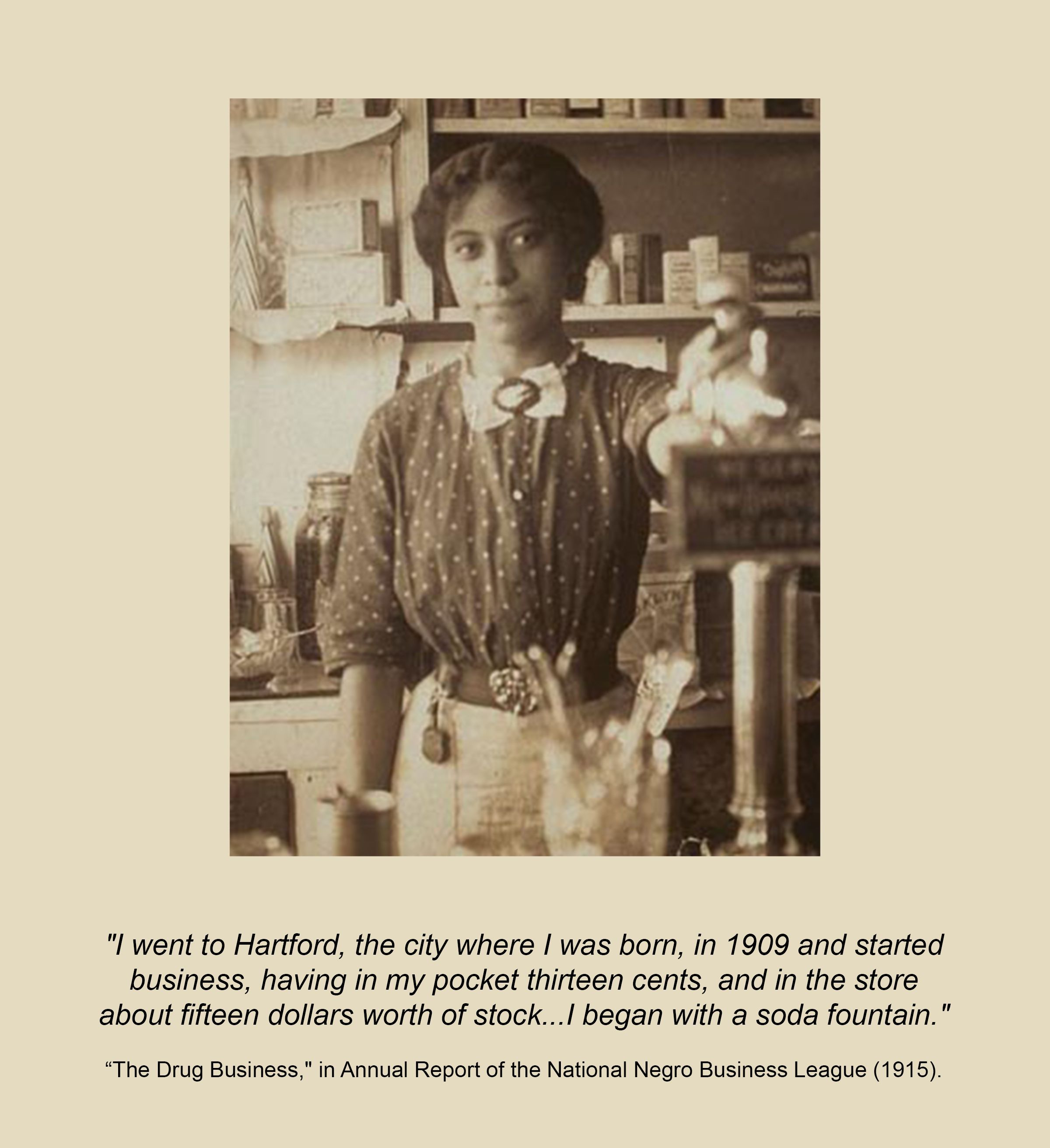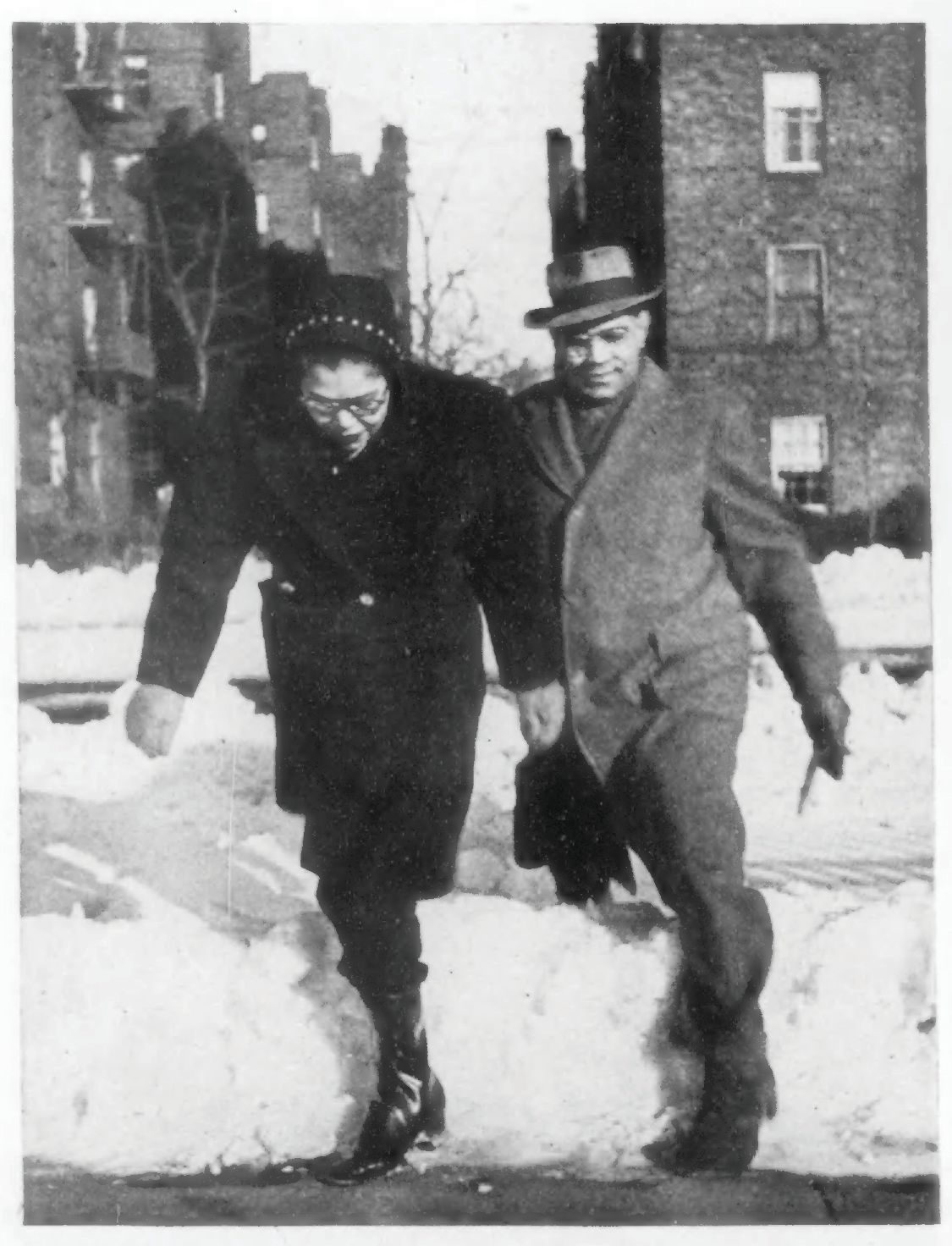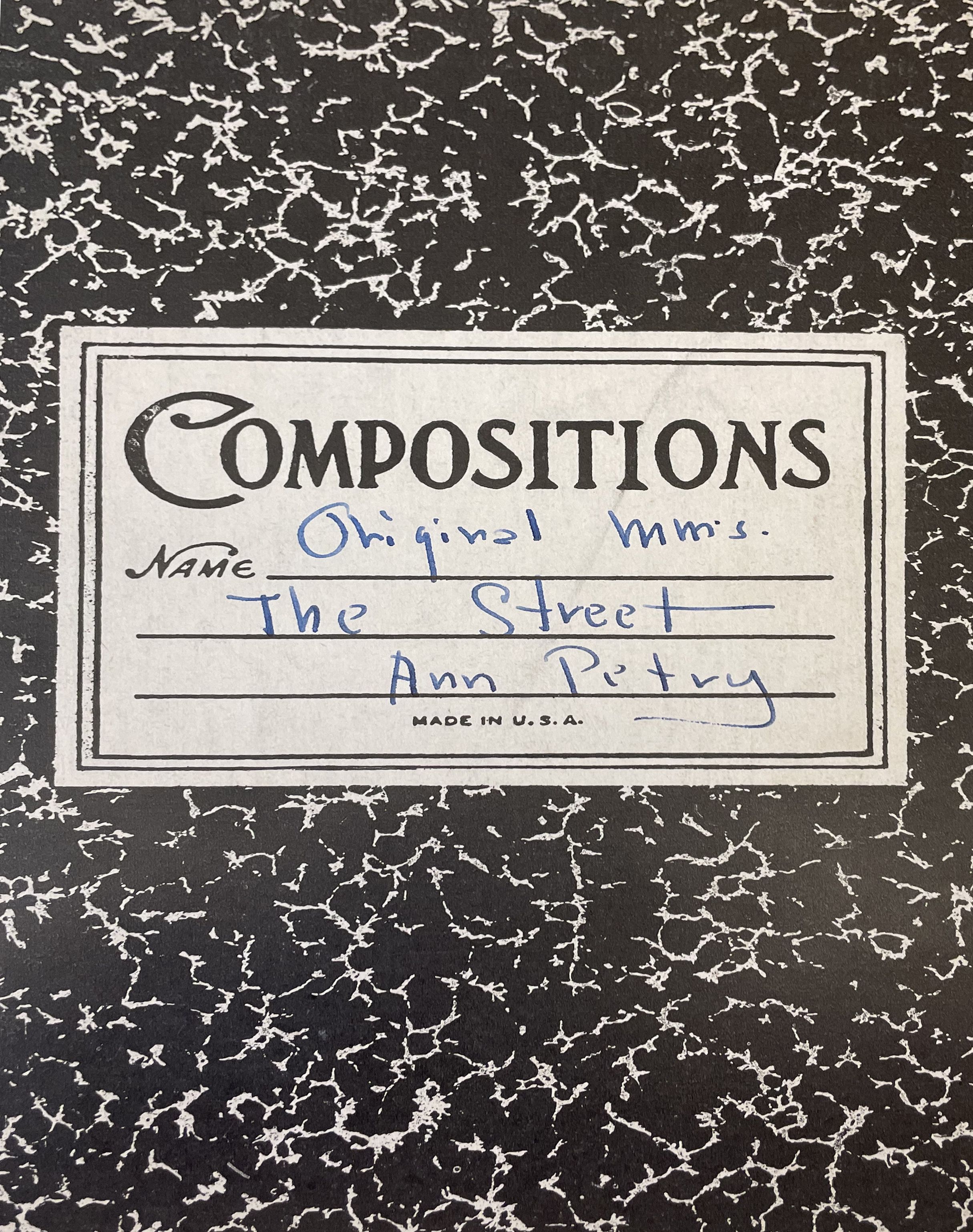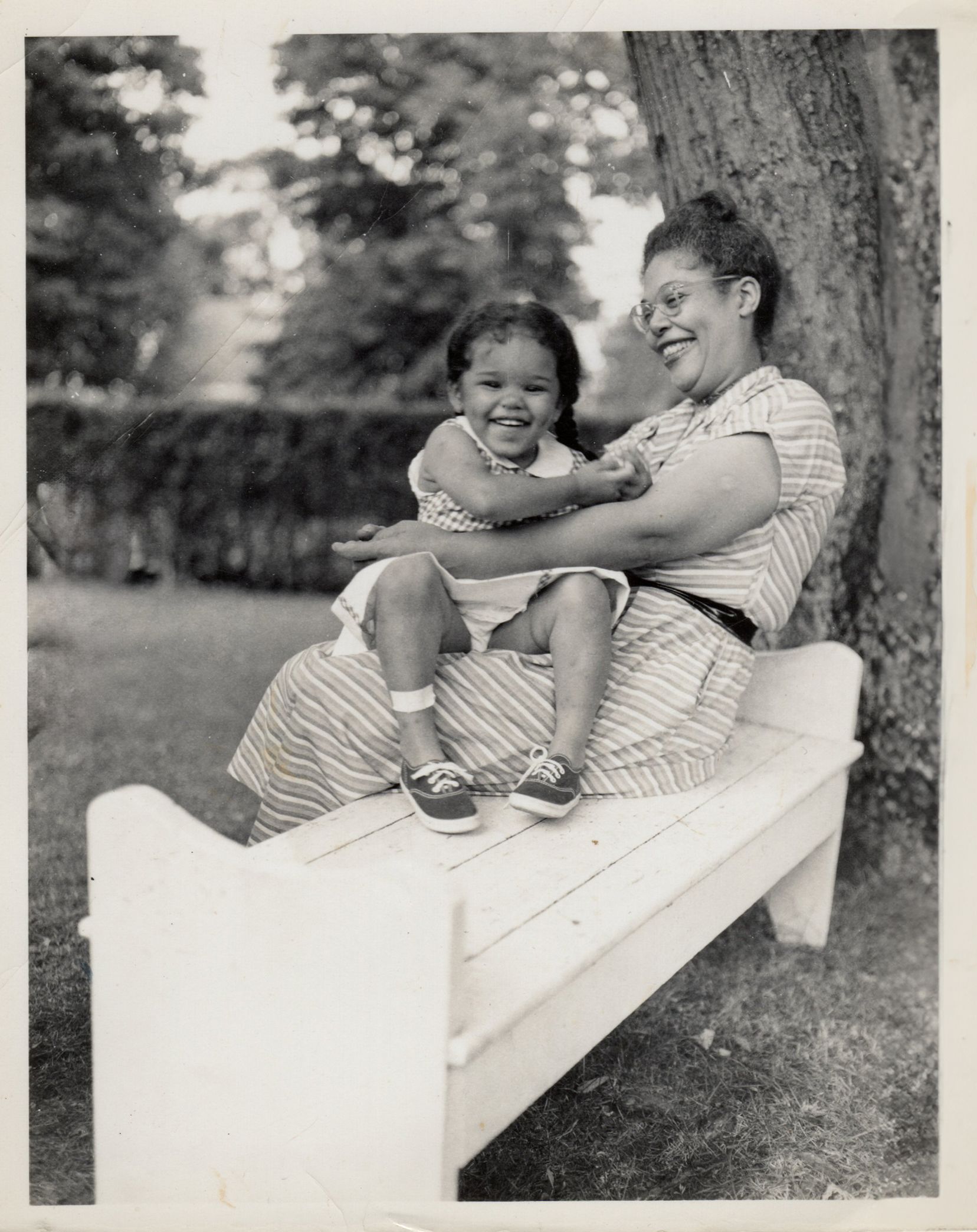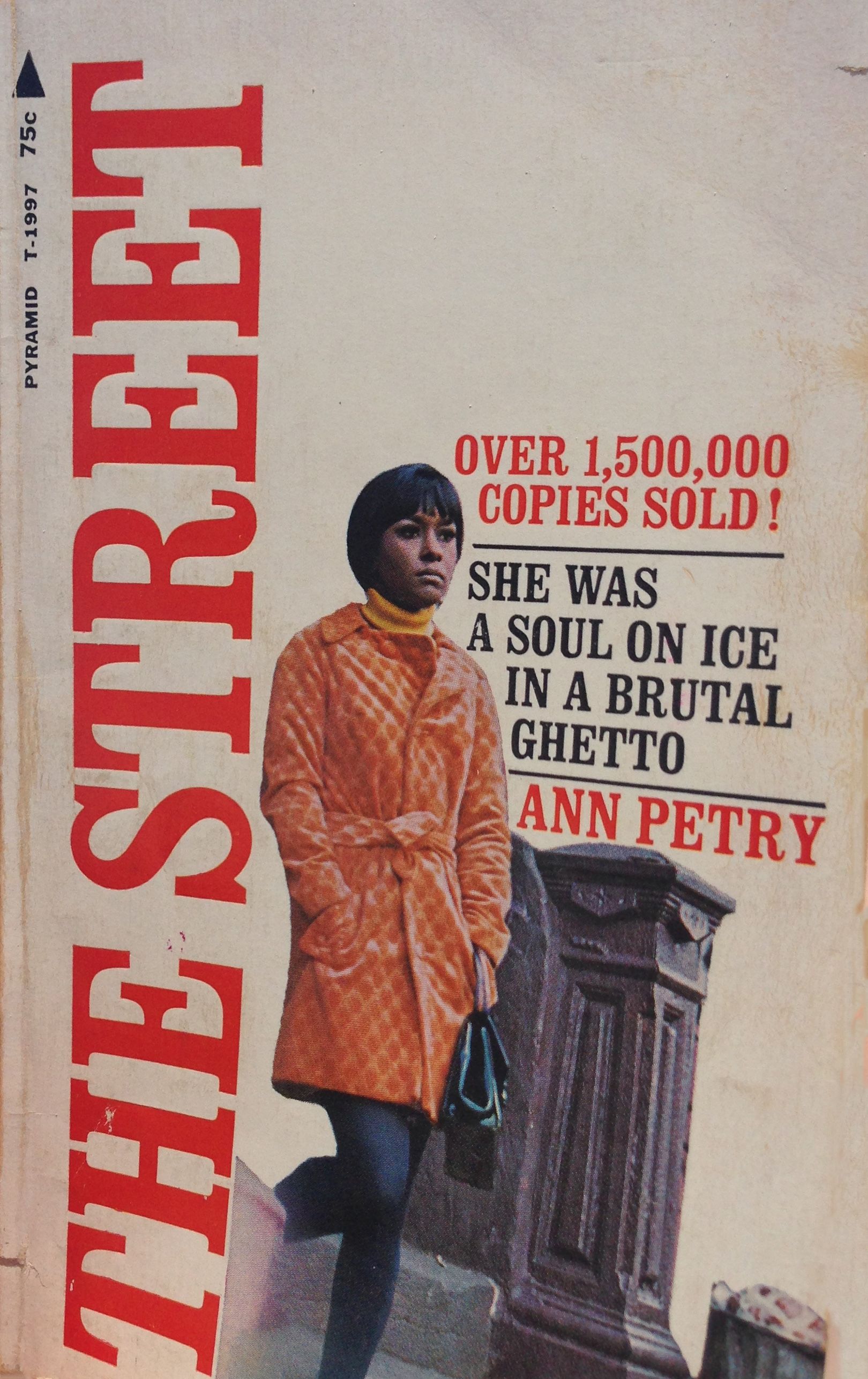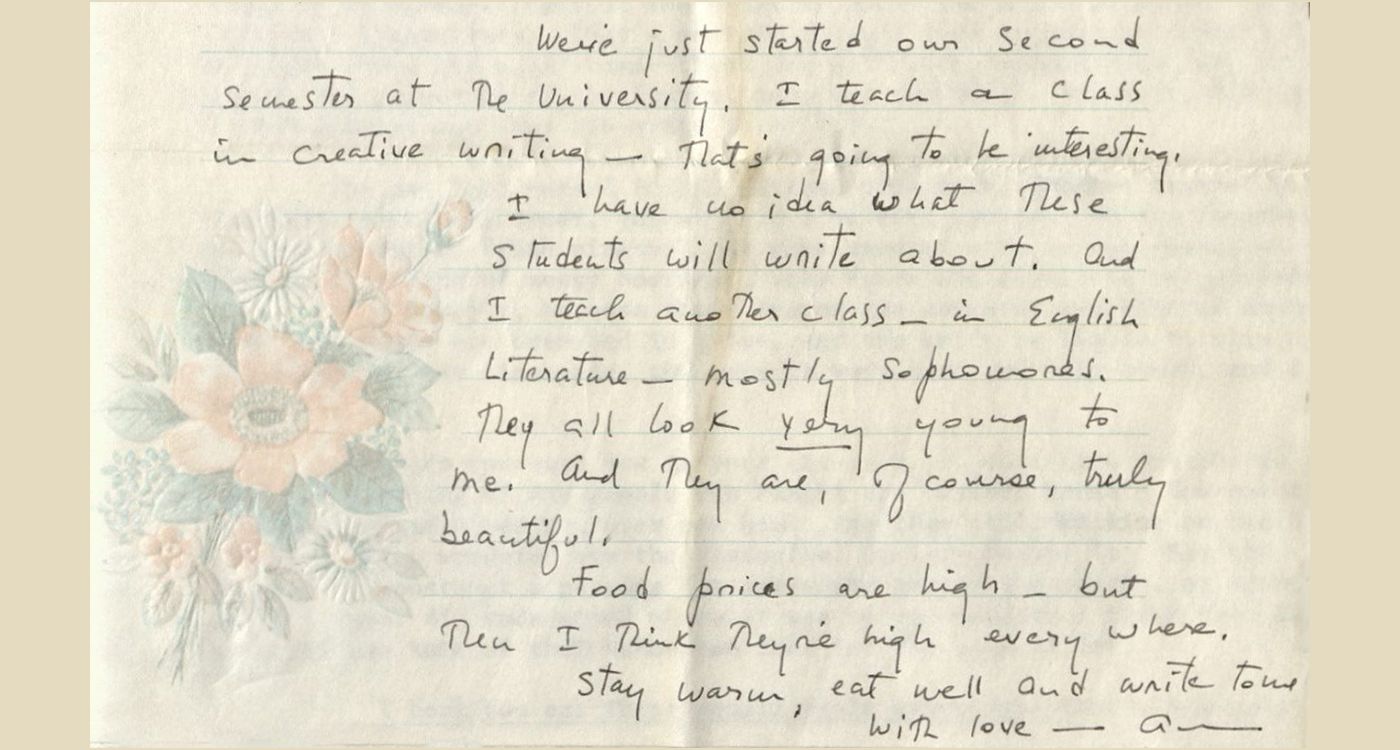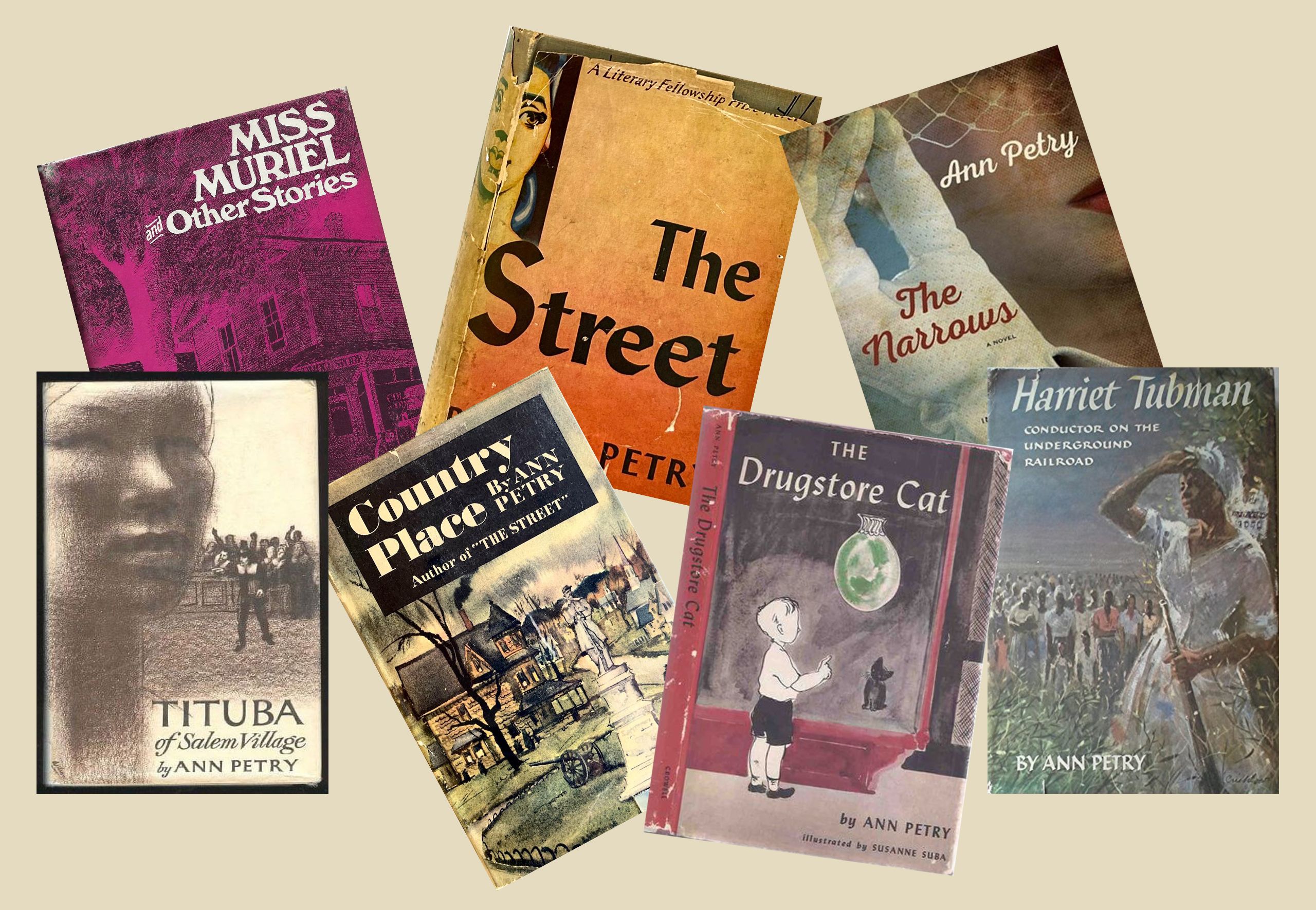
CELEBRATING
ANN PETRY
The 24th Annual John Howard Birss, Jr.
Memorial Program
February 5- April 15, 2024
Ann Petry's The Street was the first book by an African American woman to sell over a million copies. Ann came from a remarkable family. Her grandfather was a chemist, her father one of the first registered African American pharmacists in Connecticut, her mother a chiropodist and a successful businesswoman, and her aunt the first African American woman to graduate from Brooklyn College of Pharmacy and the first African American woman pharmacist in Connecticut.
Dr. Jaqueline Schachter Weiss. Temple University, interviews Ann Petry (1975).
Ann Petry's The Street was the first book by an African American woman to sell over a million copies. Ann came from a remarkable family. Her grandfather was a chemist, her father one of the first registered African American pharmacists in Connecticut, her mother a chiropodist and a successful businesswoman, and her aunt the first African American woman to graduate from Brooklyn College of Pharmacy and the first African American woman pharmacist in Connecticut.
Dr. Jaqueline Schachter Weiss. Temple University, interviews Ann Petry (1975).
1908-1920s
Anna (Ann) Houston Lane Petry was born to Peter Clark Lane and Bertha James Lane on October 12, 1908, in Old Saybrook, Connecticut. Around 1900, Peter opened a drug store in Old Saybrook, later known as the Lane Pharmacy. Ann was born over the store where the family lived until 1920.
Ann’s aunt, Anna Louise James, worked in Peter's pharmacy and lived with him and Bertha. In 1908 Anna Louise became Brooklyn College of Pharmacy's first African American woman graduate and the first African American woman licensed as pharmacist in Connecticut in 1909. After college she worked in a Hartford drugstore and then moved back to Old Saybrook in 1911 to again work at Lane Pharmacy.
“Miss James,” as she was called by the local residents, renamed the business James Pharmacy after taking over in the early1920s. She operated the pharmacy until about 1968 and continued to live there until her death in 1977.
1931
Ann earned a pharmacy degree from the Connecticut College of Pharmacy in New Haven, now the University of Connecticut School of Pharmacy in Storrs. Like her aunt, Ann was the only African American woman in her class.
After graduation, she worked at the family's pharmacies in Old Saybrook, run by her aunt Anna Louise, and in Old Lyme, run by her uncle Fritz.
1938-1946
After marrying in Old Saybrook in 1938, Ann and George D. Petry moved to New York City, where she wrote for the Amsterdam News and the People’s Voice of Harlem.
In 1939, she published her first short story "Marie of the Cabin Club" in Afro American, under the pen name Arnold Petri.
Ann and Dollie Lowther Robinson co-founded the Negro Women Incorporated in 1942, a consumer watch group that sought to help women "get their money's worth."
In 1943, Petry published "On Saturday the Siren Sounds at Noon," in The Crisis, under her own name.
She continued to write short stories throughout her life. "Like a Winding Sheet" published in The Crisis was named best American short story in 1946.
Ann applied for Houghton Mifflin's Literary Fellowship Competition and won the award in fiction for her summary of The Street. She received a $2400 stipend.
Houghton Mifflin published The Street in 1946. It sold 20,000 advance copies and translations appeared around the globe soon after its publication. Petry dedicated the book to her mother.
1947-1964
Ann and George returned to Old Saybrook to live a quieter life, and escape the public eye.
"I didn't feel like being pursued, and questioned, and all the rest of it -- flashbulbs, cameras, ooh! The most valuable asset a writer has during his (her) career is anonymity."
The couple welcomed a daughter, Elisabeth Ann (Liz), on January 28, 1949.
Ann continued to write, publishing two more novels and three children's books:
- Country Place (1947), which she dedicated to her father and to her husband.
- The Narrows (1953), which she dedicated to Mabel Louise Robinson, who taught her how to critique her own writing and how to use true events in her writing.
- The Drugstore Cat (1949), which she dedicated it to her grandmother, Anna Houston Bush, and to her aunt, Anna Louise James.
- Harriet Tubman, Conductor on the Underground Railroad (1955), which she dedicated to her daughter, Elisabeth Ann (Liz).
- Tituba of Salem Village (1964), which she dedicated to her uncle, Frank P. Chisholm.
Having been picked up and reissued in paperback by other publishers since its initial release, The Street sold over a million copies by 1961. It was the first book by an African American to reach that mark.
1971-1992
Ann published a collection of short stories, written between 1944 and 1971, in Miss Muriel and Other Stories. She dedicated the book to her brother-in-law, Walter J. Petry.
She taught creative writing at the University of Hawaii from 1974-1975 and lectured throughout the United States, including Yale University, where she spoke with a group of students taking "Black Women and their Fictions" (1983) and the University of Illinois' College of Pharmacy, where she visited with a group of pharmacy students taking "Images of Pharmacy in the Arts" (1984). Ann received honorary degrees from Suffolk University (1983), the University of Connecticut (1988), and Mount Holyoke College (1989).
Houghton Mifflin reissued The Street in 1992.
Peter Clark Lane and Bertha James Lane
Peter Clark Lane and Bertha James Lane
Ann and her husband George in NYC. Ebony, April 1946.
Ann and her husband George in NYC. Ebony, April 1946.
Manuscripts held at the Beinecke Rare Book and Manuscript Library, Yale University
Manuscripts held at the Beinecke Rare Book and Manuscript Library, Yale University
Ann and her daughter, Liz. Image courtesy of Ashley James.
Ann and her daughter, Liz. Image courtesy of Ashley James.
Pyramid Books (1961), first printing
Pyramid Books (1961), first printing
Pyramid Books (1976 ), tenth printing
Pyramid Books (1976 ), tenth printing
Excerpt from Ann Petry's letter to her aunt, Anna Louise James, Jan. 25, 1975, in the Papers of Anna Louise James, MC 440, Box 4, Folder 98, Schlesinger Library, Harvard Radcliffe Institute
Excerpt from Ann Petry's letter to her aunt, Anna Louise James, Jan. 25, 1975, in the Papers of Anna Louise James, MC 440, Box 4, Folder 98, Schlesinger Library, Harvard Radcliffe Institute
1908-1920s
Anna (Ann) Houston Lane Petry was born to Peter Clark Lane and Bertha James Lane on October 12, 1908, in Old Saybrook, Connecticut. Around 1900, Peter opened a drug store in Old Saybrook, later known as the Lane Pharmacy. Ann was born over the store where the family lived until 1920.
Before moving to Brooklyn to attend the College of Pharmacy, Anna Louise James lived with her sister and brother-in-law, Bertha and Peter, while working in Peter's pharmacy. In 1908—the same year her niece Ann was born—Anna Louise James became Brooklyn College of Pharmacy's first African American woman graduate and the first African American woman licensed as pharmacist in Connecticut in 1909. After college she worked in a Hartford drugstore and then moved back to Old Saybrook in 1911 to work at Lane Pharmacy.
“Miss James,” as she was called by the local residents, renamed the business James Pharmacy after taking over in the early1920s. She operated the pharmacy until about 1968 and continued to live there until her death in 1977.
1931
Ann earned a pharmacy degree from the Connecticut College of Pharmacy in New Haven, now the University of Connecticut School of Pharmacy in Storrs. Like her aunt, Ann was the only African American woman in her class.
After graduation, she worked at the family's pharmacies in Old Saybrook, run by her aunt Anna Louise, and in Old Lyme, run by her uncle Fritz.
1938-1946
After marrying in Old Saybrook in 1938, Ann and George D. Petry moved to New York City, where she wrote for the Amsterdam News and the People’s Voice of Harlem.
In 1939, she published her first short story "Marie of the Cabin Club" in Afro American, under the pen name Arnold Petri.
Ann and Dollie Lowther Robinson co-founded the Negro Women Incorporated in 1942, a consumer watch group that sought to help women "get their money's worth."
In 1943, Petry published "On Saturday the Siren Sounds at Noon," in The Crisis, under her own name.
She continued to write short stories throughout her life. "Like a Winding Sheet" published in The Crisis was named best American short story in 1946.
Ann applied for Houghton Mifflin's Literary Fellowship Competition and won the award in fiction for her summary of The Street. She received a $2400 stipend.
Houghton Mifflin published The Street in 1946. It sold 20,000 advance copies and translations appeared around the globe soon after its publication. Petry dedicated the book to her mother.
1947-1964
Ann and George returned to Old Saybrook to live a quieter life, and escape the public eye.
"I didn't feel like being pursued, and questioned, and all the rest of it -- flashbulbs, cameras, ooh! The most valuable asset a writer has during his (her) career is anonymity."
The couple welcomed a daughter, Elisabeth Ann (Liz), on January 28, 1949.
Ann continued to write, publishing two more novels and three children's books:
- Country Place (1947), which she dedicated to her father and to her husband.
- The Narrows (1953), which she dedicated to Mabel Louise Robinson, who taught her how to critique her own writing and how to use true events in her writing.
- The Drugstore Cat (1949), which she dedicated it to her grandmother, Anna Houston Bush, and to her aunt, Anna Louise James.
- Harriet Tubman, Conductor on the Underground Railroad (1955), which she dedicated to her daughter, Elisabeth Ann (Liz).
- Tituba of Salem Village (1964), which she dedicated to her uncle, Frank P. Chisholm.
Having been picked up and reissued in paperback by other publishers since its initial release, The Street sold over a million copies by 1961. It was the first book by an African American to reach that mark.
1971-1992
Ann published a collection of short stories, written between 1944 and 1971, in Miss Muriel and Other Stories. She dedicated the book to her brother-in-law, Walter J. Petry.
She taught creative writing at the University of Hawaii from 1974-1975 and lectured throughout the United States, including Yale University, where she spoke with a group of students taking "Black Women and their Fictions" (1983) and the University of Illinois' College of Pharmacy, where she visited with a group of pharmacy students taking "Images of Pharmacy in the Arts" (1984). Ann received honorary degrees from Suffolk University (1983), the University of Connecticut (1988), and Mount Holyoke College (1989).
Houghton Mifflin reissued The Street in 1992.
Peter Clark Lane and Bertha James Lane
Peter Clark Lane and Bertha James Lane
Ann and her husband George in NYC. Ebony, April 1946.
Ann and her husband George in NYC. Ebony, April 1946.
Manuscripts held at the Beinecke Rare Book and Manuscript Library, Yale University
Manuscripts held at the Beinecke Rare Book and Manuscript Library, Yale University
Ann and her daughter, Liz. Image courtesy of Ashley James.
Ann and her daughter, Liz. Image courtesy of Ashley James.
Pyramid Books (1961), first printing
Pyramid Books (1961), first printing
Pyramid Books (1976 ), tenth printing
Pyramid Books (1976 ), tenth printing
Excerpt from Ann Petry's letter to her aunt, Anna Louise James, Jan. 25, 1975, in the Papers of Anna Louise James, MC 440, Box 4, Folder 98, Schlesinger Library, Harvard Radcliffe Institute
Excerpt from Ann Petry's letter to her aunt, Anna Louise James, Jan. 25, 1975, in the Papers of Anna Louise James, MC 440, Box 4, Folder 98, Schlesinger Library, Harvard Radcliffe Institute
1997
Ann Petry passed away in Old Saybrook on April 28, 1997. After her mother's death, her daughter, Liz, found letters from their ancestors that her mother had saved. She compiled and edited the letters for Can Anything Beat White?: A Black Family's Letters (2005). A few years later she published At Home Inside: A Daughter's Tribute to Ann Petry. Before Liz passed away in 2023, she and her cousin, Ashley James, and his wife, Kathryn Golden, began working on a documentary “Ann Petry and the James Family Letters.”
Liz Petry, Ann's daughter, talks about their family history.
1997
Ann Petry passed away in Old Saybrook on April 28, 1997. After her mother's death, her daughter, Liz, found letters from their ancestors that her mother had saved. She compiled and edited the letters for Can Anything Beat White?: A Black Family's Letters (2005). A few years later she published At Home Inside: A Daughter's Tribute to Ann Petry. Before Liz passed away in 2023, she and her cousin, Ashley James, and his wife, Kathryn Golden, began working on a documentary “Ann Petry and the James Family Letters.”
Liz Petry, Ann's daughter, talks about their family history.
Keynote
with Jesse Nasta
Where Ann Petry Came From:
How the Novelist's Family and Community Shaped Her
Ann Petry came from a remarkable family. Descendants of self-emancipated enslaved people who made new lives in Connecticut in the Civil War era, Petry's forebears distinguished themselves in medicine, business, and education, inspiring the stories that Ann Petry wrote and the person she became.
Jesse Nasta, PhD, specializes in the history of slavery, emancipation, and their aftermaths, with a particular emphasis on New England. He has been a professor in Wesleyan University’s African American Studies Department since 2017 and is Executive Director of the Middlesex County Historical Society in Middletown, Connecticut. He is speaking as a personal friend and research collaborator of Ann Petry's daughter, Elisabeth Petry (1949-2023).
Keynote
with Jesse Nasta
Where Ann Petry Came From:
How the Novelist's Family and Community Shaped Her
Ann Petry came from a remarkable family. Descendants of self-emancipated enslaved people who made new lives in Connecticut in the Civil War era, Petry's forebears distinguished themselves in medicine, business, and education, inspiring the stories that Ann Petry wrote and the person she became.
Jesse Nasta, PhD, specializes in the history of slavery, emancipation, and their aftermaths, with a particular emphasis on New England. He has been a professor in Wesleyan University’s African American Studies Department since 2017 and is Executive Director of the Middlesex County Historical Society in Middletown, Connecticut. He is speaking as a personal friend and research collaborator of Ann Petry's daughter, Elisabeth Petry (1949-2023).
We'd like to thank our project partners
Old Saybrook Historical Society
Beinecke Library (Yale University)
Schlesinger Library (Harvard Radcliffe Institute)
The Honors Program at Roger Williams University
With special thanks to
Roger Williams University alumnus, Robert Blais '70, for endowing the John Howard Birss, Jr. Memorial Program

